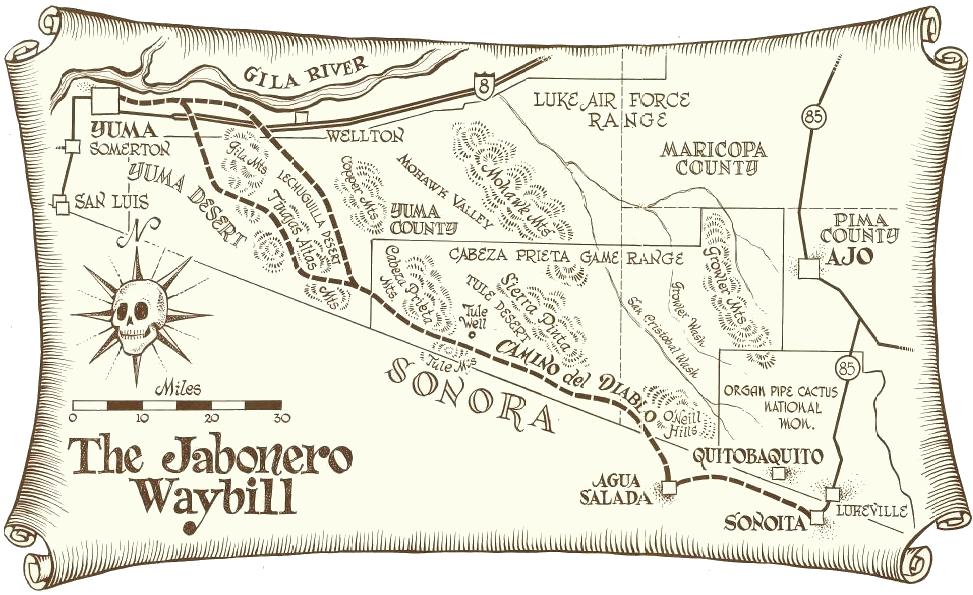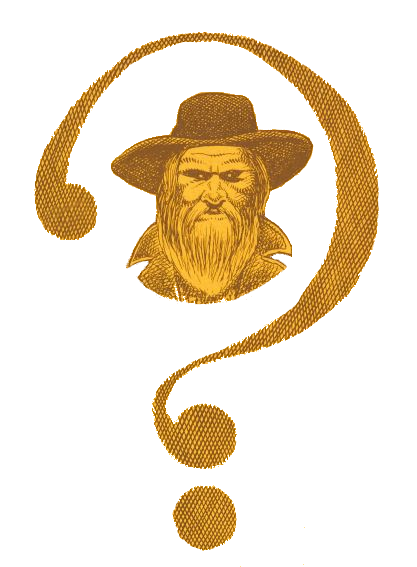
In the Southwest of Spanish tradition there are two ancient trails with sinister names.
One is the Jornado del Muerto, on the old route of the conductas between El Paso del Norte and Santa Fe. The Jornado is where the trail leaves the security of the Rio Grande and, for miles, traverses rocky, waterless desert.
The other is the Camino del Diablo of the Sonoran Desert's blazing heat and stinging winds. It lies along the Mexican border, westward from the village of Sonoita to the Gila River near Yuma.
Of the two, the Camino- the Devil's Highway- is by far the most deadly. There is scant water and it is bien escondido- well hidden. How many travelers have perished from thirst on the Camino is a secret buried in the blowing sands, but it is known that most of the were gold-seekers from Mexico who had joined the California gold rush of 1849.
The Camino is the setting for the story of the Lost Jabonero. Two of the men who figured in the story were Forty-Niners from Sonora. The third was the soapmaker of Sonoita- El Jabonero.
The story of the humble citizen of Sonoita is an old one and has been told many ways. El Jabonero himself told it to C.O. Bustamente of Tucson, when the soapmaker was an old man living in Los Angeles. Bustamente wrote of the gold in a letter to Gus Livingston of Yuma and told of it to his son. The younger Bustamente related Jabonero's tale to Jose Alvarado of Yuma. Alvarado recalled the story for Harold O. Weight, who combined all of the stories in his booklet "Lost Mines of Old Arizona."
This is the skeleton of the story:
The two Sonorans were returning, empty-handed, four or five years after the California gold rush. Somewhere west of Sonoita- near Agua Salada, Tule Tank, or Tinajas Altas- they discovered a ledge heavily laced with gold. They had three samples smelted and assayed at Sonoita, and the samples were two-thirds gold.
Their supplies were gone and their horses were worn out. They made a contract with El Jabonero to provide them with mules and provisions, and they made him a full partner. Equally important was the soapmaker's knowledge of the country: he knew where the water was.
The three rode out, for the gold, but only one came back and he was in a desperate condition. Whether they had reached the ledge of gold, or were still en route to it, is not known. But while they were camped at Agua Salada they were set upon by Los Arenenos- the Sand Papagos- and the two Sonorans were killed. El Jabonero was left for dead but after the Indians rode away with their plunder, he made his way, slowly and painfully, back to Sonoita.
The head wounds inflicted by Papago war clubs caused El Jabonero's vision to fade and in time he became blind. Because of his blindness he could not hunt for the gold himself.
In 1878 he asked Bustamente to write down the words for his will- a waybill leaving to his daughter a dream of golden riches. It was a strange document, and the clues to his "estate" were 11 "puntos de recuerdo"- points of call.
Here is what Bustamente wrote:
Point 1- From Quitobaquito take the old road to Tinajas Altas.
Point 2- Then to the end of the Pinto Mountains.
Point 3- Go from the Pintos to Cabeza Prieta Mountain.
Point 4- There is a well of water at Cabeza Prieta.
Point 5- Cross an arroyo where the road divides, one fork leading to Tinajas Altas, and the other to Mohawk on the Gila River.
Point 6- Standing at the road fork, look right. Three peaks standing along are seen. On the opposite side of the middle peak is the mine.
Point 7- Follow the arroyo in the direction of said peaks. There is a big flat rock there, with crowbars pointing to the peaks of said mine.
Point 8- We were attacked at the foot of said peaks. The little peaks cannot be seen from no other place but only from the fork of the old road leading from Quitobaquito to Tinajas Altas. On the other side of the middle peak there is water and there is where the gold is.
Point 9- You must take great care to find the fork of the road because only from here can the peaks be seen and cannot be seen from no other place.
Point 10- To be sure of your direction, ask of the old folks at Sonoita where is the old road leading from Quitobaquito to Tinajas Altas. It may be hard to find because of the years.
Point 11- I ask of you, if you find the mine, to help my daughter. This is my Last Will and Testament and I witness it with my signature.
El Jabonero

Somewhere Out There Cache Series
GC6ZVBF- The Hassayampa Strongbox
GC6ZVBB- The Organ Grinder's Ledge
GC6ZVB7- The Wickenburg Payroll
GC6ZVB9- The Black Prospector's Secret
GC6AV5B- The Lost Frenchman
GC6BDGK- The Jabonero Waybill
GC7EGMW- Four Peaks Gold
GC7EGKH- The Tonto Quartz
GC7EVJX- Lost Gold of Sanders
Congratulations to skipandjessie on staking claim to El Jabanero's stash.